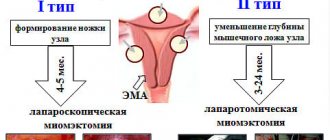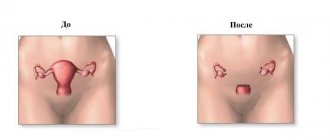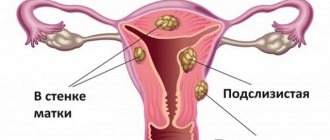All over the world, standard treatment for cervical cancer consists of removal of the uterus, chemotherapy and radiation therapy. However, for young women who want to maintain the ability to bear children, an alternative operation has been developed - trachelectomy, or removal of the cervix.
What is trachelectomy and is it possible to get pregnant after it?
To ensure that the outcome of cervical removal is favorable, the selection of patients for this procedure is critical. During the operation, the cervix, upper 2 cm of the vagina and adjacent tissue are removed. The body and vault of the uterus remain intact. The intervention can be performed through the abdominal cavity, laparoscopically, or using robot-assisted surgery. It is possible to remove the cervix through the vagina.
The first successful operation was performed in 1994. Over the past time, at least 1000 such interventions have been carried out, after which at least 250 women were able to become pregnant.
There are two types of operations:
- Simple with removal of part of the cervix and vagina.
- Radical with additional excision of lymph nodes in the pelvis, where cancer cells may be located, as well as the parametrium (tissue around the uterus).
The treatment method is accompanied by a low risk of complications. The tumor recurrence rate does not exceed 5%.
Indications for cervical amputation
Sometimes there are situations when it is necessary to remove the cervix and uterus. Often this procedure is prescribed when an oncological process appears. If it is detected in a timely manner, it can be treated, but in advanced cases, it may be necessary to remove not only the cervix, but also the uterus itself.
For diagnosis, doctors use a PAP test, namely a cytological smear to identify cells with an atypical structure. Using the test, you can determine the presence of precancerous and cancerous changes occurring on the cervix.
Dysplasia is considered a particularly dangerous pathology. The fact is that the disease is quite difficult to diagnose because it occurs without pronounced symptoms. And if it is not detected in a timely manner, it can lead to the development of an oncological process.
It is worth paying attention to the indications of certain treatment methods:
- knife removal. This surgical intervention is indicated when the first stage of oncology is detected. The procedure is performed using a scalpel, which is used to excise the neck. Then the affected area, tissue with a parametric structure and the upper area of the vagina are removed. The main advantage of this type of surgical intervention is the complete preservation of the woman’s reproductive health;
- radio wave conization. This type of operation is used to detect severe pathological processes such as dysplasia and cancer. Removal of the affected organ is carried out with special instruments - a diathermoelectrosurgical device and an electrode (Games-Rogovenko). But it is worth paying attention to the fact that this removal procedure has contraindications - pathologies in the structure of the organ, the presence of acute inflammation, leukocytosis and others;
- laser removal. This method of operation is prescribed for dysplasia and benign formation. During the procedure, the surgeon cauterizes the area where the tumor is located. After some time, scar tissue forms in this place;
- cryodestruction. During this surgical intervention, the affected area is exposed to liquid nitrogen. After some time, under the influence of low temperature, complete death and destruction of cell membranes and tissues occurs. This method of treatment should not be used in the presence of acute inflammatory process and endometriosis;
- ultrasonic removal. This method has the same indications as laser removal. The removal process is the same as laser surgery, the difference is that ultrasound is used;
- radiosurgical surgery. Radio waves destroy the affected cells. It is considered the safest and most effective treatment method.
Pregnancy 3 months after cervical amputation
74 replies
Last - 08 November 2021, 11:31 Go
Guest
It was specially amputated for you so that you could have children in the future. Don't have an abortion, why? But it is better for you to continuously be under the supervision of competent doctors. Health to you and the baby!
Guest
Your text
Girls, are you really that stupid when you want to get pregnant? The author underwent surgery for a serious illness that could have taken her to the grave. On the oncology forum, grade 3 dysplasia = stage zero cancer.
The area with atypical cells was also removed, but that’s not all – the tendency of normal cells to become dangerous remained in the body. And pregnancy almost always causes a relapse of the disease.
But fools don’t care about that, the main thing for them is to give birth.
Guest
Your text
Girls, are you really that stupid when you want to get pregnant? The author underwent surgery for a serious illness that could have taken her to the grave. On the oncology forum, grade 3 dysplasia = stage zero cancer.
The area with atypical cells was also removed, but that’s not all – the tendency of normal cells to become dangerous remained in the body. And pregnancy almost always causes a relapse of the disease.
But fools don’t care about that, the main thing for them is to give birth.
Guest
[/attention]
And she is very competent, she travels all over the world to conferences, she herself is a Doctor of Science.Guest
[/attention]
And she is very competent, she travels all over the world to conferences, she herself is a Doctor of Science.Masha
My doctor's guest, the girl carried her without a cervix at all and gave birth on time. She sewed up her uterus and put her to bed for the rest of her life. Do I have ICN? The neck doesn’t hold up at all and is short, there were 2 losses, I went to this doctor and everything was ok, here’s my miracle snuffling next to me)). I was stitched up too.
And she is very competent, she travels all over the world to conferences, she herself is a Doctor of Science.
Write, plz plz plz... cervical amputation a year and a half ago, diagnosis: 2nd degree dysplasia. The doctors all agree to wait at least a year and you can get pregnant.
Now I went with this question, I’ve heard a lot about the topic “you need to give birth healthy, but this is not about you, forget even thinking about it, you can’t stand it longer than the second trimester...” etc. Tell me how to find a doctor with a different view on this issue
Guest
[/attention]
And she is very competent, she travels all over the world to conferences, she herself is a Doctor of Science.Tatiana
My doctor's guest, the girl carried her without a cervix at all and gave birth on time. She sewed up her uterus and put her to bed for the rest of her life. Do I have ICN? The neck doesn’t hold up at all and is short, there were 2 losses, I went to this doctor and everything was ok, here’s my miracle snuffling next to me)). I was stitched up too.
And she is very competent, she travels all over the world to conferences, she herself is a Doctor of Science.
Please, can you give me the doctor’s contact details (to [email protected] )
Guest
[/attention]
And she is very competent, she travels all over the world to conferences, she herself is a Doctor of Science.Guest
[/attention]
And she is very competent, she travels all over the world to conferences, she herself is a Doctor of Science.Guest
[/attention]
And she is very competent, she travels all over the world to conferences, she herself is a Doctor of Science.Guest
[/attention]
And she is very competent, she travels all over the world to conferences, she herself is a Doctor of Science.Guest
[/attention]
And she is very competent, she travels all over the world to conferences, she herself is a Doctor of Science.Guest
[/attention]
And she is very competent, she travels all over the world to conferences, she herself is a Doctor of Science.Alyona
Olga, give birth and don’t think about anything bad, I’m expecting a second one and after the first pregnancy and childbirth I was healed of many ailments like a woman.
Believe me, pregnancy and childbirth will only benefit you!!! There will be some difficulties, of course, but you will survive them!!! Since God gave you pregnancy, he will help you carry it! Health to you and your baby! Don’t listen to anyone who scares you, listen to your heart, it will never deceive! Don’t be afraid of anything, everything will be fine!
Guest
The author – during pregnancy, all the forces of the body are activated and immunity increases. Pregnancy cured me of a fairly serious illness - before pregnancy a tumor was found, but after pregnancy - NOT!!! I've been pregnant for 4 years now - thank God, nothing so far.
Don’t be afraid, try to keep it. I wish you and your baby happiness and health.
Zhanna
Please, give me the doctor’s coordinates too...Thank you!
Guest
[/attention]
And she is very competent, she travels all over the world to conferences, she herself is a Doctor of Science.Guest
[/attention]
And she is very competent, she travels all over the world to conferences, she herself is a Doctor of Science.Anna
Hello girls! It turns out I'm not alone with this problem. I also don’t have a cervix and I was told that I would never become a mother. can you give me the contact information for this doctor? I will be very, very grateful to you.
Guest
[/attention]
And she is very competent, she travels all over the world to conferences, she herself is a Doctor of Science.Guest
[/attention]
And she is very competent, she travels all over the world to conferences, she herself is a Doctor of Science.Guest
[/attention]
And she is very competent, she travels all over the world to conferences, she herself is a Doctor of Science.Source: https://www.woman.ru/health/Pregnancy/thread/4109651/
Is it possible to get pregnant after removing the cervix?
Is it possible to get pregnant if the cervix is removed? This question interests many women, but it is worth considering that this may depend on many conditions. The main ones include the following:
- a disease that led to the removal of the uterus;
- maintaining the activity of the reproductive system;
- presence or removal of the uterus;
- complexity and type of surgical intervention;
- the patient's condition;
- age.
Approximately 15% of patients after trachelectomy may experience difficulties associated with narrowing of the lower part of the cervical canal. In these cases, assisted reproductive technologies are required, for example, in vitro fertilization (IVF).
If pregnancy occurs after cervical amputation, there is a low risk of miscarriage during pregnancy. But at the same time, the frequency of premature births increases. This pathology usually occurs due to the presence of a short neck or due to the presence of chorioamnionitis. This can cause premature rupture of the membranes.
If you believe statistics, 4% of women experience labor before 32 weeks of pregnancy, and 55% of women experience labor after 37 weeks. To prevent premature termination of pregnancy, sutures are placed on the cervical area or special holding devices are installed - pessaries.
Indications
Surgery is indicated not only for cervical cancer. It is performed in the following pathological conditions:
- recurrent cervical cysts and polyps, chronic endocervicitis;
- cervical endometriosis;
- a small node of fibroids in the cervix;
- cervical deformation and ectropion caused by the unfavorable course of previous births;
- prolapse or prolapse of the uterus, causing thickening and deformation of the cervix;
- severe leukoplakia or pseudoerosion that cannot be treated by other means.
The cervix is often removed in cases of grade 2 and 3 dysplasia - precancerous processes of the cervix. Conservative methods at this stage are usually no longer effective, and there is no need for complex surgical intervention.
In 1998, the following indications for removal of the cervix were formulated:
- the patient’s desire to maintain the opportunity to have a child;
- tumor less than 2 cm in size;
- FIGO stage 1A1, 1A2 and 1B1;
- uninvolved upper part of the cervical canal, as proven by MRI;
- absence of metastases in the lymph nodes.
If at least one of these conditions is not met, partial removal of the cervix while preserving the organ is impossible.
Tumors larger than 2 cm are usually accompanied by involvement of lymphatic vessels and nodes, as well as the cervical canal. This increases the frequency of tumor relapse and the likelihood of metastases.
The operation is not performed on patients with the following histological forms of cervical tumors:
- neuroendocrine tumors;
- papillary-serous formations;
- sarcomas.
Before performing neck removal, it is important to exclude metastatic disease of the lymph nodes. To do this, before the main operation, lymph nodes are removed laparoscopically, through small incisions in the abdominal wall. If cancer cells are found, the entire uterus is removed.
Cervical rupture - consequences and pregnancy
A woman can often encounter such an unpleasant phenomenon as perforation of the reproductive organ. This is a fairly serious pathology that is difficult not to detect.
In addition to pain in the lower abdomen, other unpleasant symptoms may occur:
- contraction of the uterine walls;
- extensive internal bleeding;
- decreased heart rate;
- decreased blood pressure;
- dizziness;
- general weakness is noted.
If treatment is not started in time, serious complications and consequences may occur:
- Severe blood loss. Cervical rupture is usually accompanied by increased bleeding. When divergence of the walls occurs, damage to the vessels of the internal membranes is observed. If internal bleeding occurs during pregnancy, this process is usually accompanied by severe contractions. With increased blood loss, a woman experiences severe pain in the lower abdomen, and blue discoloration may appear near the navel. If help is not provided in time, death may occur;
- Infertility. If a uterine rupture occurs during childbirth, then serious consequences may arise in the future, including complete loss of the possibility of childbearing. If the presence of this pathology is not detected in time, doctors may perform a complete removal of the reproductive organ. This procedure helps save a woman's life. But after it she remains infertile for the rest of her life, he will no longer be able to bear a child and give birth;
- Adhesive process in the pelvic area. When a cervical rupture occurs along the scar or outside this area, bleeding often leads to the appearance of adhesions. This process is accompanied by the entry of fluid into the abdominal cavity, which cannot come out completely. Over time, it becomes thick, films are formed, which cause the internal organs to stick together. This process is accompanied by constant pain in the lower abdomen and disruption of the internal organs;
- Severe inflammation and infection. After a rupture of the cervix, a strong wound is formed into which germs and bacteria can enter. All this causes a strong inflammatory process. Usually sutures are placed on the hole with tears. Drug therapy using antibiotics is also carried out.
If a cervical rupture occurs, but the reproductive organ itself is completely preserved, then doctors allow women to become pregnant. But at the same time, they recommend giving birth by caesarean section. The fact is that natural childbearing can lead to a recurrence of cervical rupture.
Is it possible to get pregnant with prolapsed uterus?
Uterine prolapse is not considered a contraindication for pregnancy. This especially applies when this condition occurs in the first and second stages; during this period, signs can only be identified by a specialist during a diagnostic study.
Prolapse usually does not have a negative impact on the process of bearing and giving birth to a child. During the first trimester of pregnancy, a woman may experience discomfort, but after 12 weeks they completely disappear.
There are no contraindications to pregnancy due to genital prolapse, because this condition does not have a negative impact on pregnancy. During the period of childbearing age, stage 4 of uterine prolapse does not occur, when part or all of it falls out of the vagina.
But if a woman experiences complete uterine prolapse, then in these cases a diagnosis is prescribed. During the examination, the doctor determines the causes of the loss. In these situations, pregnancy can cause serious harm to health and cause complications.
Cervical ectropion and pregnancy
Ectropion of the cervix is considered a pathological condition in which it is inverted. But it is not considered a contraindication for childbirth. But often cervical inversion is accompanied by a number of unpleasant conditions:
- inflammatory processes;
- pseudo-erosion;
- gross cicatricial changes in the cervix.
All of the above symptoms can lead to unpleasant consequences. Because of them, a woman will not be able to bear a child normally, infection of the fetus may also occur, and cervical ruptures may occur during childbirth. They can also become the main indications for a cesarean section. And in severe cases, infectious complications in the form of metroendometritis may occur in the immediate prenatal period.
In any case, if serious problems with the organs of the reproductive system are observed, it is worth carrying out a full diagnosis. It is better to start conceiving a baby when the woman’s health is in normal condition, otherwise this may have a negative impact on the process of bearing and giving birth to the baby.
Various gynecological operations have different effects on the patient's future ability to have children. Much also depends not only on the nature of the intervention, but also on the reason for which it was carried out, what consequences, complications and features it had. After some of them, pregnancy is not possible at all, after others it is unlikely, after others the reproductive function is not impaired in any way or is restored quite quickly. In this article we will consider one of the types of such operations and the possibility of conception after its implementation. Is pregnancy possible after removal of the cervix, and what features can it have?
Immediate complications
The postoperative period and the first weeks after removal of the cervix may be accompanied by complications:
- inability to completely empty the bladder due to decreased tone;
- pain during sexual intercourse;
- vaginal discharge;
- bleeding;
- deep vein thrombosis, pulmonary embolism;
- infectious complications and inflammation of sutures;
- decreased skin sensitivity on the thighs;
- painful or irregular periods;
- swelling of the external genitalia, including the labia, clitoris and vaginal opening;
- vaginal candidiasis;
- prolonged absence of menstruation.
Prevention of these complications:
- Sexual activity is permitted after 6 weeks, when a follow-up medical examination has been performed and the first menstruation after the intervention has passed.
- During the same period, douching, vaginal tampons, hot baths, swimming, and lifting weights of more than 3 kg are prohibited.
- In the first six months you need to protect yourself from pregnancy.
To alleviate her condition after discharge, it is better for a woman to take care of a supply of food in advance and discuss household chores with loved ones.
If, after removal of the cervix, the lower abdomen hurts, discharge with an unpleasant odor appears, your health worsens, or your temperature rises, you should immediately consult a doctor. Normally, the discharge can last 6 weeks; it is spotty, brown in color, and painless. If bright red discharge or clots appear, you should consult a gynecologist.
Is it possible?
In order to answer the question of whether it is possible to get pregnant after such a procedure, it is necessary to understand how exactly the cervix is involved in the process of conception. It connects the vagina and the uterine cavity. Thus, it is through it that sperm from the vagina enter the uterus, where fertilization occurs. It turns out that if there is no cervix, then it is impossible to get pregnant?
This is not entirely true. Much depends on the technology used to amputate this part of the organ. For example, often only part of the cervix is removed, if possible, and leaving part of it is not harmful to health. In other cases, almost the entire cervix is removed, but if possible, only a small portion of it is left. With this condition, even natural pregnancy is possible, although its probability is much lower.
The likelihood of pregnancy in this case reduces the development of adhesions in the cervix, when adhesions do not allow sperm to penetrate into the cavity. About the same thing happens with swelling of the mucous membrane, which is also possible after surgery. Sometimes other complications arise, such as changes in the functioning of the glands, and when the production of cervical mucus decreases, it is more difficult for sperm to enter the uterine cavity, etc.
In some cases, the cervix is completely removed, not even a small section of it remains. In this case, natural pregnancy is almost completely impossible. But since the uterus is preserved. If hormonal levels are maintained at normal levels and the ovaries are functioning, it is still possible to carry a child to term. You just need to use the in vitro fertilization procedure, since problems arise in this case exclusively at the stage of conception.
Cervical amputation
But the main problem that reduces or eliminates the likelihood of a natural pregnancy is considered to be a narrowing of the cervical canal. This problem cannot be eliminated and is an indication for in vitro fertilization. But it occurs only in 15% of patients who have undergone such an intervention.
Terms of conception
Regardless of whether natural conception is planned or through the use of reproductive technologies, you need to prepare for it in a special way if there is no cervix. In particular, it is generally possible to plan pregnancy no earlier than six months or a year after the intervention. A doctor will help you determine the timing of possible conception more precisely, since much in this case depends on the state of health, the speed of healing, the individual characteristics of the body and the reproductive system.
Preparing for conception
Strictly speaking, pregnancy after removal of the cervix does not require any special manipulations or preparatory processes. You need to prepare for it the same way as for a regular one. For example, if natural conception was previously carried out without any drug preparation, then it may not be carried out now. As for in vitro fertilization, to make it more successful, the patient is almost always medicated to prepare for it. The case when the cervix is absent is no exception.
Separately, it is worth considering cases when the patient persistently wants to get pregnant on her own after such an operation, but the likelihood of this is very low. In this case, various auxiliary methods and technologies can be used.
Cervix. Tumor cells
Features of gestation
Carrying without a cervix has no special features. Although this organ normally undergoes significant changes during gestation, its complete absence has almost no effect on pregnancy, in particular, the likelihood of miscarriage does not change in any way. If the patient is in good health and this probability did not exist before, then the absence of a cervix will not increase it. And vice versa - if the patient had problems with frequent miscarriages, then the absence of a cervix will not solve and will not aggravate this problem.
However, despite the fact that the risk of miscarriage itself does not increase in any way, there are still some features characteristic of pregnancy in the absence of a cervix:
- The likelihood of premature onset of labor increases, which occurs because the cervix is shorter or absent (it should be shortened on the eve of childbirth, and then return to normal after it);
- There is a high probability of developing chorioamnionitis - the process of inflammation of the amniotic membranes as a result of bacteria entering them (which becomes more likely if the cervix is absent);
- The main feature of childbirth in this condition is the impossibility of its natural vaginal resolution, that is, the child cannot be born naturally, but only by caesarean section.
In fact, the most serious problem is precisely premature birth, which is natural in this condition. At the same time, about 55% of patients without a cervix give birth after the 37th week of gestation, and about 4% of patients give birth even before the 32nd week. At the same time, this problem is quite easily solved - special narrowing sutures or retaining pessaries are applied to the cervix. Such systems can prevent excessive cervical dilatation and the premature birth that may follow.
In general, we can say that in the absence of a cervix, the probability of giving birth to a healthy child is quite high. Gestation proceeds normally, without serious complications or deterioration of the condition. The absence of a part of the organ does not have any negative impact on the fetus or the birth process itself. On the contrary, there are a number of subjective opinions that the labor process without a cervix becomes even easier, and its duration decreases.
Postoperative follow-up
The first doctor's examination is scheduled after 2 weeks. In this case, a vaginal examination is not performed. The woman is informed of the results of a biopsy of the removed tissue. A plan for further observation and treatment is discussed.
Pap tests and colposcopy are performed every 3-4 months for the first 3 years after the intervention. Then control examinations are performed once every six months for 2 years.
The doctor pays attention to the appearance of long-term side effects of the operation, which may appear even several years after the intervention:
- accumulation of lymph in the vessels of the extremities (lymphostasis) or in the abdominal cavity (lymphocele) due to removal of the pelvic lymph nodes (this complication is especially typical for situations where trachelectomy was combined with radiation);
- stress urinary incontinence due to activities that increase intra-abdominal pressure, such as sneezing;
- problems with conception and a high risk of pregnancy complications.
Consequences and complications
Are there any possible consequences or complications after pregnancy in this condition? There are usually no serious specific consequences. But there are complications associated with caesarean section. Among them:
- Scar formation;
- The presence of adhesions;
- Infection;
- Prolonged or excessive bleeding;
- Stable and severe pain syndrome of high intensity;
- Suture endometriosis, etc.
A specific feature is that the cervix will take longer to close after childbirth, and the organ cavity itself will take longer to return to normal size. But this is individual and not typical for all patients. Depending on the characteristics of the body, there may be a number of individual complications and consequences, the minimization of which is carried out by the doctor.
Types and procedure for cervical amputation surgery
Amputation of the cervix is carried out in two ways:
- laparoscopically;
- through the vagina.
Laser, electric current, ultrasound, radio rays, and cold can also be additionally used. The average duration of the operation is about half an hour. If there are any complications (such as bleeding), it may take longer.
General and local anesthesia is used. Regional anesthesia has recently become very popular: an injection is given into the spinal canal, as a result of which the sensitivity of the entire lower part of the body is turned off. After the patient has fallen asleep under anesthesia, doctors begin the operation.
Removal of the cervix can be carried out using three methods:
- according to Schroeder, when the tissues of the anterior and posterior lips of the neck are excised with a wedge;
- according to Sturmdorf - the remote part is a funnel (cone) that goes deep into the neck;
- high amputation - complete removal of the cervix, while the surgeon makes incisions on the vaginal mucosa.
During the operation, depending on the complexity of the pathology, only the cervix or the cervix along with part of the vagina can be removed. Then the doctor puts stitches. In most cases, self-absorbing threads are used, less often - nylon threads.
All other organs are preserved, which in the future allows the woman to become pregnant and give birth to a healthy baby.
Even with a properly performed operation, the following complications can occur:
- relapse – after some time the disease may form again;
- damage to the bladder - most often occurs if it was not emptied before surgery;
- slipping of ligatures, which can subsequently cause bleeding;
- high risk of infection (sepsis, suppuration, peritonitis);
- prolapse of intestinal loops through the vagina;
- necrosis of the vaginal dome.
If such consequences cannot be treated conservatively, additional surgical intervention will be required.
Conclusion
Pregnancy after cervical amputation is possible. It is for this reason that doctors often prescribe this type of intervention. It is also important to understand that removal of the cervix is carried out for very important reasons, on which not only the health, but often the life of the patient depends. In particular, the most common indication for manipulation is an oncological process on the cervix - invasive or non-invasive cancer.
At the same time, this intervention is far from the most effective and is much inferior in terms of effectiveness to complete removal of the organ. For this reason, such intervention is carried out by gynecological oncologists only in patients who have a persistent desire to give birth in the future; in other cases, when the goal is to avoid relapse of the disease, the cervix and organ are completely removed.
Therefore, if the doctor persistently recommends complete removal of both the organ and the cervix, then it is better to agree with him, as this can save the patient’s life. After all, even in the absence of an organ, it remains possible to have a child by resorting to surrogate pregnancy or adoption.
I had surgery to remove the cervix, upper part of the vagina and regional lymph nodes (trachelectomy). The uterus and ovaries remained. Doctors allowed the pregnancy. Please tell me, has anyone had such an operation and someone gave birth to a baby after that? What were the difficulties and where were they observed? I live in Ukraine. The operation was performed in Israel. Thank you very much in advance
Woman.ru experts
Find out the opinion of an expert on your topic
Spiridonova Nadezhda Viktorovna
Psychologist. Specialist from the site b17.ru
Semikolennykh Nadezhda Vladimirovna
Psychologist. Specialist from the site b17.ru
Veronica Viktorovna Dobroselskaya
Psychologist, Weight correction. Specialist from the site b17.ru
Wrzecinska Eva
Psychologist. Specialist from the site b17.ru
Antakova Lyubov Nikolaevna
Psychologist, Consultant. Specialist from the site b17.ru
Tiselskaya Ekaterina Vladimirovna
Psychologist. Specialist from the site b17.ru
Korotina Svetlana Yurievna
Psychotherapist. Specialist from the site b17.ru
Nekrasova Natalia
Psychologist. Specialist from the site b17.ru
Anastasia Sergeevna Shikhaleeva
Psychologist. Specialist from the site b17.ru
Carrying out
Before surgery, antibiotics are recommended to prevent infection. Sometimes an enema is performed or the patient takes a substance that cleanses the intestines in advance. This depends on the type of intervention contemplated.
A woman should take a hygienic shower. Sometimes pubic hair removal is required. Jewelry, glasses, contact lenses, and piercings are removed.
The patient is placed on a surgical gynecological chair. General or local anesthesia is used. Epidural anesthesia is often performed.
Trachelectomy is performed in one of three ways:
- Removing part of the neck in the form of a cone.
- Wedge resection.
- Amputation with vaginal vault transplantation.
To perform the operation, various instruments can be used: scalpel, laser, electric current, cryodestructor or radio knife. The choice is made by the doctor depending on the capabilities of the clinic and the characteristics of the patient.
How long does cervical removal surgery take?
Depending on the type of intervention – from 30 minutes to 4 hours.
Vaginal removal
First, several pelvic lymph nodes are removed using laparoscopy. They are examined for the presence of malignant cells. If there are no metastases, the cervix is removed. The probability of detecting malignant cells in the lymph nodes at an early stage is 6%.
Radical vaginal trachelectomy is performed most often and consists of 5 stages. First, a local anesthetic drug with a vasoconstrictor effect is injected under the mucosa and a circular incision is made 2 cm below the neck. The anterior and posterior edges of the mucosa are clamped.
The space between the uterus and rectum is then opened and treated. After this, the tissue between the uterus and bladder is opened.
Radical trachelectomy
The ureters and uterine vessels are isolated, and the periuterine tissue is removed. With a simple trachelectomy, the parametrium is not excised. They try to preserve the blood supply to the uterus as much as possible. The arteries leading to the cervix are ligated. The cervix is incised at a level of 1 cm below the internal os.
The removed area of the cervix is urgently examined under a microscope. If cancer cells are found at a distance closer than 5 mm from its edge, the operation is considered ineffective, its volume is expanded and the uterus is removed.
Removal of part of the cervix
At the final stage, they try to restore the cervix as much as possible using non-absorbable materials. Subsequently, such a stitch, partially covering the cervical canal, helps to maintain and carry out pregnancy. A rubber catheter is left in the cervical canal, which is subsequently removed. The edges of the vaginal mucosa are sewn to the cervix.
Cavity removal
Abdominal surgery to remove the cervix is performed with a low horizontal or vertical incision in the abdominal wall.
The opened abdominal cavity is carefully examined in search of metastases. All pelvic lymph nodes on both sides are removed. They are immediately assessed using the frozen section method. If malignant cells are found in them, extensive surgery is necessary.
The ligaments of the uterus and ureters are distinguished. The vaginal part is opened through the posterior surface of the uterus and the outer surface of the cervix is removed. Stitches are applied.
Laparoscopic surgery
Thin instruments in the form of tubes and optical devices are used. The surgeon makes short incisions in the abdominal wall. The laparoscope is inserted through these small holes and the cervix and adjacent tissue are removed under video control. This operation is the least traumatic for the patient. After it, a quick recovery is dismissed.











